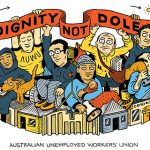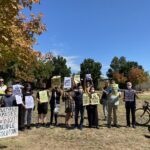Bipartisan Punishment of the Jobless Coexists with Necessary Unemployment Economics

Social services minister Amanda Rishworth was congratulating her government in July, after it budgeted for an unemployment benefit rise, which means that as of 20 September, those on base level JobSeeker will receive a $40 rise a fortnight and with indexation, she added, that’s $56.
The minister neglected to mention, however, that on the ground this translates to a $4 a day rise in the middle of a cost-of-living and rental crisis. And this slap in the face comes as the unemployed are right now living on $346 a week, while the official poverty line is $601 per week, including housing.
The political football that the unemployed have increasingly become since the mid-1990s shift to Centrelink and a privatised job network is now so pervasive that ministers hardly have to apply any effort to kicking it to awaken the trope of the dole-bludger in the public mind, so ingrained is it.
Punishing the unemployed is a tool that both major parties use when in need of a scapegoat to blame for economic woes or serve as a distraction. Turnbull proposed introducing welfare drug testing, whilst Morrison’s Robodebt scheme morphed into an extermination program.
And another stark aspect to this societywide demonisation of people who are unemployed is that since the late 1970s shift to neoliberalism, Australian economic systems have been underpinned by the premise that a certain level of unemployment is desirable in order to keep inflation down.
“The undeserving poor”
“It’s just a pittance. To call this a rise during the cost-of-living crisis doesn’t show any justice to what they’re doing,” said Antipoverty Centre spokesperson Jay Coonan. “They’re not taking proactive action because they want to buy into that dole bludger rhetoric.”
“They’ve kept payments low as rents have ballooned since the pandemic. People are still locked out of work and into poverty,” he added. “Not only are they on such a low rate, but they’re also subjected to mutual obligations that don’t allow them the time or space to escape the punishment.”
Mutual obligations are a series of tasks, such as searching for a set number of jobs, that those on benefits must perform to warrant payment. What these tasks involved has steadily been increased since the mid-90s to the point that they leave recipients with no time to actually find a job.
Since the Howard era, successive governments had denied the unemployed any raises in welfare payments, with the last having occurred under Keating in 1994.
Yet, when mass unemployment struck under COVID in early 2020, so many were unemployed that the punishment stopped. Payments rose above the poverty line. And when it picked up again, the jobless were dropped back into poverty with a mere $25 a week rise on the pre-pandemic rate.
“It’s this race to the bottom to see who can punish the unemployed and push that rhetoric about the undeserving poor,” Coonan told Sydney Criminal Lawyers. “Politicians believe they can look strong in terms of people ‘rorting the system’, that’s why the rate is continuously so low.”
The necessary unemployed
But there’s a more sinister aspect to long-term government demonisation of the poorest of the poor in our society, which is that while ministers wax lyrical about getting down the unemployment rate at every chance they can, the logic that supports our economic systems requires some to be jobless.
The Reserve Bank of Australia outlines the three objectives of its monetary policy are to achieve stability of currency, full employment and economic prosperity and welfare. And The Treasury is currently producing a white paper with full employment as its key theme.
But as Reserve Bank deputy governor Michele Bullock noted during a speech in June, full employment does not mean that everybody works. And neither it does even adhere to the official definition that everybody who wants to work has a job because of skill mismatches.
And Bullock further outlines that Australian economics also runs on the concept that “if unemployment remains too low for too long, inflation expectations will rise, which will make it that much harder for the monetary authorities to bring inflation back down”.
So, what she is saying is that the Australian economy runs on this neoliberal principle of a desired level of unemployment to keep inflation down, which is officially known as the Non-Accelerating Inflation Rate of Unemployment or the NAIRU. And this level of unemployment is said to benefit all.
As the Reserve Bank deputy governor further outlined in June, this “spare capacity in the labour market”, the unemployment rate, is expected to rise to 4.5 percent by late 2024, which, “while higher than the current rate” will bring the economy closer to “a sustainable balance point”.
Keeping them hungry
“The now former Reserve Bank governor Philip Lowe wanted to see unemployment in order to bring inflation down,” Coonan makes clear. “And it’s also the opinion of the current Reserve Bank governor that unemployment will result because of the leverage of which they hold.
And while federal Labor, in undertaking its white paper inquiry, is talking big on full employment to “achieve economic prosperity and growth” and lauding the unemployment rate being at its lowest in 50 years, its pre-inquiry paper into the issue makes no mention of the NAIRU.
So, this talk of overhauling the labour market in order to maintain current low levels of unemployment, doesn’t necessarily mean that Labor is going to ensure long-term jobless people are successfully employed within this foreseen climate of prosperous economic growth.
Indeed, as Coonan points out, even after Albanese established the Economic Inclusion Advisory Committee in order to deal with the “unemployed and disadvantaged”, he wasn’t going to raise the rate at this year’s surplus budget, despite record low numbers, until he bowed to political pressure.
“People living in poverty and the unemployed are a political football politicians get to kick around by calling lazy or bludgers, when they know full well that there’s nothing they can do about that because that’s the way the economy operates,” Coonan explained.
“People have to be sacrificed at the economic altar to ensure others can get ahead, or they ensure that a certain demographic or area is trapped in poverty and there’s no escape,” he added in ending. “Then they utilise that narrative to escape criticism for actually having created the issue.”







